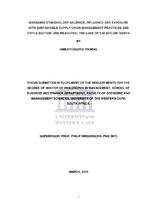| dc.contributor.advisor | Hirschsohn, Philip | |
| dc.contributor.author | Thomas, Ombati Ogoro | |
| dc.date.accessioned | 2018-08-14T08:39:47Z | |
| dc.date.available | 2018-08-31T22:10:07Z | |
| dc.date.issued | 2018 | |
| dc.identifier.uri | http://hdl.handle.net/11394/6263 | |
| dc.description | Philosophiae Doctor - PhD (School of Business and Finance) | |
| dc.description.abstract | As organizations face stiff pressure from various stakeholders, management
has had to move beyond the idea of shareholder wealth maximization and
incorporate the environmental and social concerns from the various
stakeholders. The study identifies how Sustainable Supply Chain Management
(SSCM) practices enable the firm to manage the social, environmental and
economic Triple Bottom Line (TBL) for four key stakeholder groups - customers,
suppliers, regulators and the community.
The study adopted a case study design, focused on Safaricom, arguably
Africa's most innovative cellular firm which has championed the M-pesa money
transfer platform. The objectives were, first, to establish key attributes namely;
power, legitimacy and urgency of selected stakeholders of Safaricom and the
key determinants of their salience, second, to determine stakeholder
expectations and how they hold Safaricom accountable; third, to identify the
extent of Safaricom's influence and control over the selected stakeholders; and
finally, to establish how and to what extent the firm manages stakeholder
exposure through their SSCM practices and TBL measures.
Data from semi-structured interviews with Safaricom management and the four
key selected stakeholder groups, together with company and public
documents, were analyzed using qualitative content analysis. Stakeholder
groups were selected to represent examples of low, moderate or high levels of
salience and exposure. While all are considered important, the case reveals
how Safaricom management prioritizes and addresses stakeholder needs
according to their attributes. As each stakeholder group is heterogeneous, the
case reveals how the firm manages each distinctively and adopts diverse
SSCM practices, which are aligned with the firm's TBL measures. Moreover,
stakeholder exposure has a moderating effect on the relationship between the
firm's SSCM practices and the TBL measures. | |
| dc.language.iso | en | |
| dc.publisher | University of the Western Cape | |
| dc.subject | Stakeholders, Stakeholder Salience, Stakeholder Exposure, Sustainable Supply Chain Management Practices, Sustainability, Triple Bottom Line, Cellular Industry, Safaricom, Kenya | |
| dc.title | Managing stakeholder salience, influence and exposure with sustainable supply chain management practices and triple bottom line measures: The case of Safaricom, Kenya | |
| dc.rights.holder | University of the Western Cape | |

